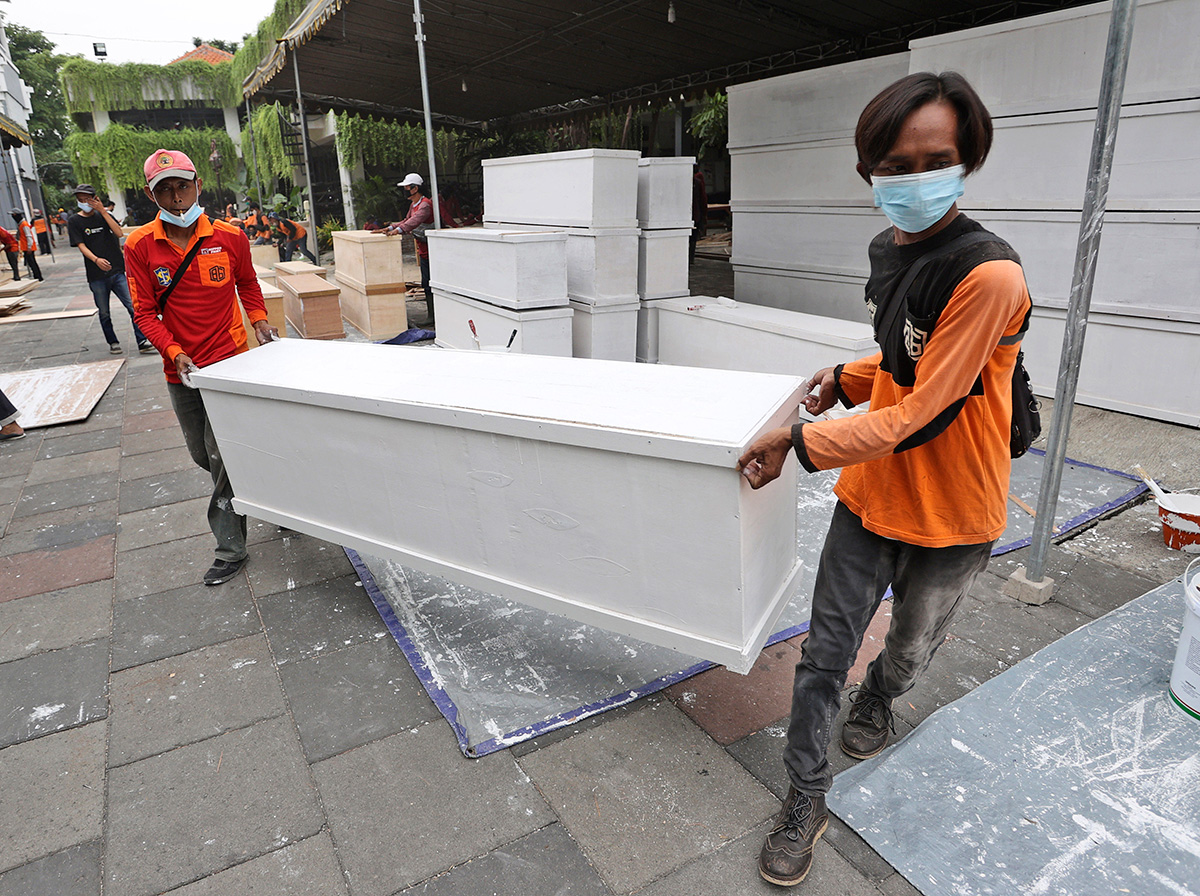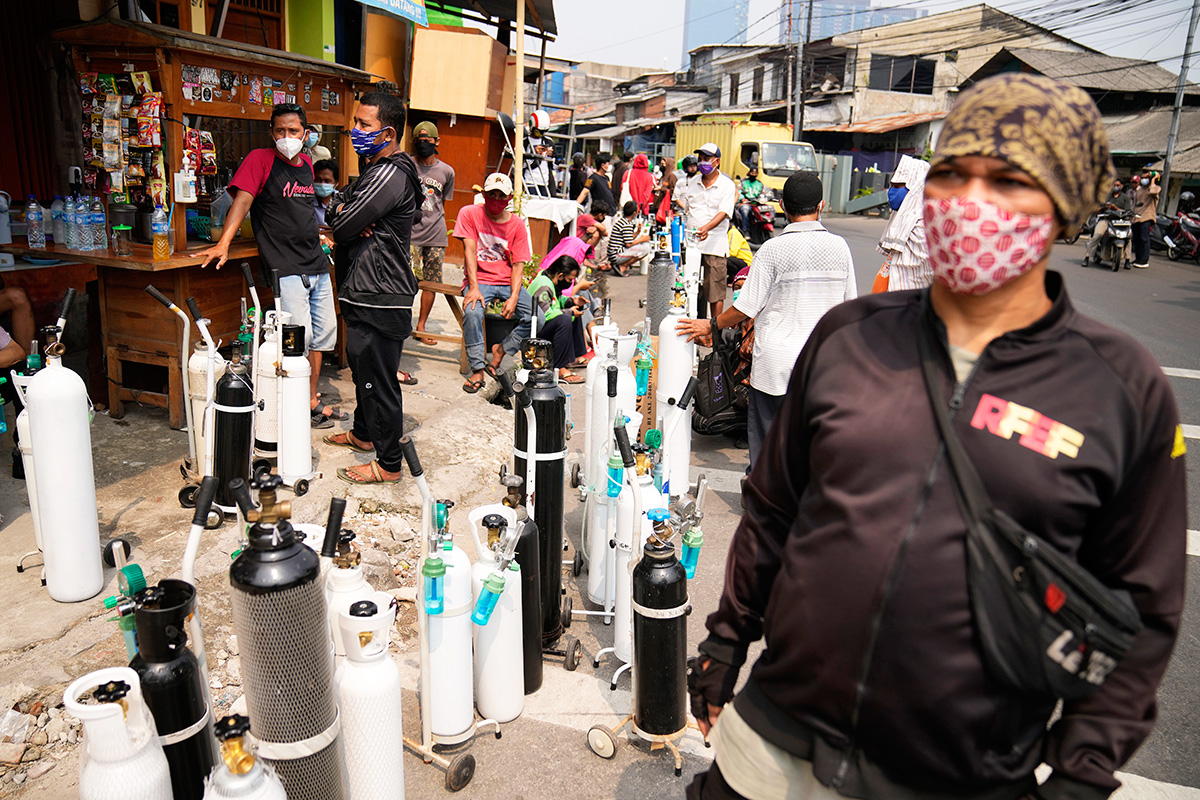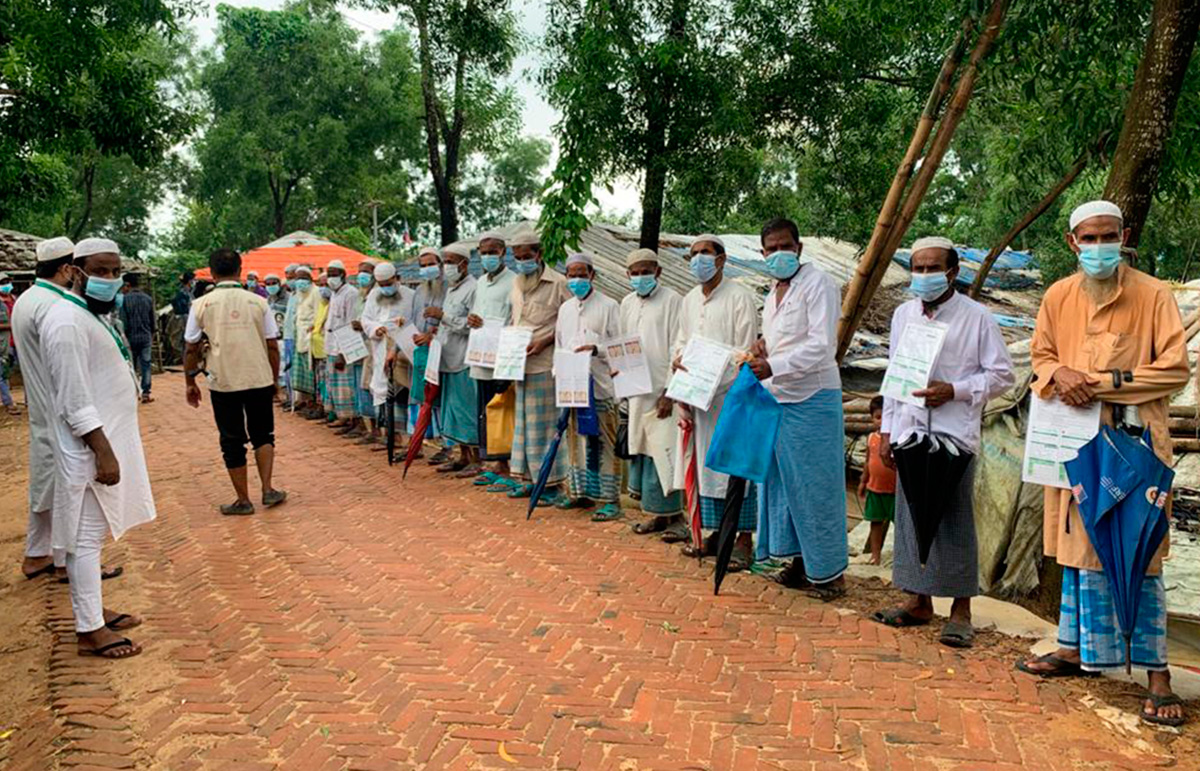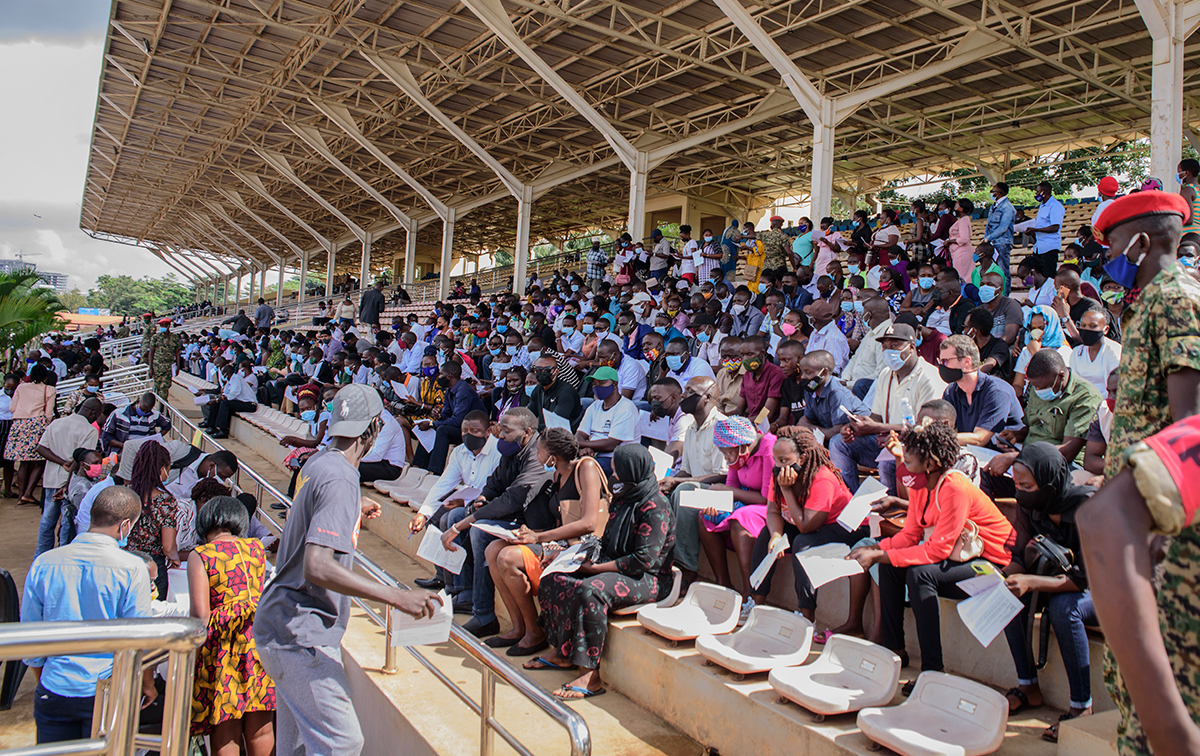Oppressive, Parasitic Workings of Imperialism Continue Needless COVID-19 Horrors, Part 2
| revcom.us
A number of articles posted at revcom.us have exposed how the workings of capitalism-imperialism have led to needless horrors under the COVID-19 pandemic:
- Production of PPE (personal protective equipment) was subject to the workings of global supply chains in a lopsided world of rich capitalist-imperialist countries and poor countries—where much of PPE was made in Third World sweatshops where workers are subjected to oppressive conditions;
- The U.S., Britain, Europe, and other imperialist powers funded pharmaceutical companies in a serious drive to develop vaccines, but the competition between these countries to gain economic, political and strategic advantage, and to make sure their country got vaccinated first, constantly got in the way of the necessary pooling and sharing of knowledge and undercut the whole effort;
- The U.S. and other rich countries hoarded the vaccine to amass even more vaccines than needed to vaccinate their population—even as they blocked efforts to suspend “intellectual property rights,” (like patents) that prevent companies in Third World countries from cheaply producing and distributing vaccines; and
- The workings of imperialism ensured there would be no equitable distribution of vaccines worldwide and that vaccine production remained largely in the hands of industrialized countries.
ALL OF THIS has not only continued but gotten even more horrific.
Part 1 of this article examined how the pandemic has exacerbated poverty and hunger, especially in poor Third World countries; and looked at the ways already existing inequalities have been deepened with COVID-19.
Part 2 examines how the lopsided nature of a world with rich and poor countries is reflected in not only percentage of the population vaccinated, but also the levels of danger, death, and suffering in different countries.
Inequality of Death from COVID-19
As of August 21, 2021, there have been over 211 million reported cases of COVID-19 worldwide. And at least 4.4 million people have died of this disease.1 Both figures are rising every day. These numbers are horrific enough, but the actual numbers of COVID-19 cases and deaths are much higher.2
Disparities in how different countries do and don’t have access to vaccinations, and the persistence of many people resisting getting vaccinated, have created a situation where the COVID-19 pandemic continues to cause needless suffering and death. The problem of people not wanting to get vaccinated can be addressed by educating people about the disease and dispelling anti-scientific notions and conspiracy theories about the vaccines. But the problem of huge gaps between different countries in access to vaccines and ability to treat COVID-19 reflects the systematic lopsidedness in the world between rich and poor countries—and this cannot be ended without ending the oppressive system of capitalism-imperialism that engenders these inequalities and disparities.
Vaccinations are one of the most important ways to prevent COVID-19 from continuing to spread.3 And vaccination rates provide one of the starkest illustrations of the huge gap between rich and poor countries in being able to deal with the COVID-19 pandemic. Among the countries that have been able to fully vaccinate at least 50 percent of their population as of August 2021, most are rich countries outside the Third World. Meanwhile, of the 57 countries that have vaccinated less than 10 percent of their population, most are in the Third World. And of the 20 countries that have vaccinated less than two percent of their population, at least half are on the African continent.4
Among the Hardest Hit: Indonesia and Bangladesh
There is a complexity of many factors involved in whether a surge in COVID-19 cases and deaths is able to be curbed in different countries. But overall, it is clear that richer countries are able to access and administer vaccines to a larger percentage of their populations than poor countries. And poverty and lack of health care in poor countries—which existed before COVID-19 and have been made worse by the pandemic—are also huge factors.
Two of the hardest hit countries are Indonesia and Bangladesh5: In Indonesia, where less than 10 percent of the people had been vaccinated as of August 11, coffin makers cannot keep up with the growing number of dead from COVID-19. Hospitals face shortages of oxygen and hospital beds. Cemeteries are running out of space to bury those who have died of COVID-19, and in the capital city of Jakarta lush fields are being cleared for new cemeteries.
It was a year from the start of the pandemic before the total number of deaths from COVID-19 went over 50,000 people in Indonesia. But the highly transmissible Delta variant of COVID-19 has led to a new explosion of cases and deaths. In only nine weeks after reaching the 50,000 mark, the number of deaths doubled—making Indonesia the global epicenter of this pandemic, surpassing India and Brazil in the number of daily cases. At the height of this recent surge, new infections peaked at over 56,700 in one day. And on July 27 alone, over 2,000 people died of COVID-19. Many of these deaths have been among children—in July, more than 100 children a week died from COVID, many under the age of five.6
In Bangladesh, only three percent of the population was vaccinated as of August 10. The country had been on a very tight lockdown earlier this year because of the pandemic. But then in late July, there was a pause on its tight lockdown for just over a week to allow people to prepare for and celebrate the Muslim holiday of Eid al-Adha. In the face of a crippling economic crisis, government officials said this could help the economy. After the Eid celebrations—which involved huge gatherings of people—the government announced the strict lockdown would be re-instituted. But cases surged exactly two weeks after the temporary lift in restrictions. New daily cases reportedly surpassed 15,900 a day—and this figure was considered to be much lower than the actual number of cases.
Different Factors Involved
Rich countries with many more resources—money, doctors, health care, etc.—have been able to combat surges in COVID-19 cases and deaths much more effectively than poor countries. But it has also been the case in some richer countries, for example in the United States, that “opening things up” and people not wearing masks and not getting vaccinated have led to dramatic new surges. In the United States, the number of new cases per day went from over 101,000 on January 31, 2021, to less than 17,000 a day at the end of June, but has now gone up to over 157,000 new cases on August 20. Daily deaths in the U.S. went from a high of over 4,100 people in a day in January 2021 to as low as 139 on July 11 and has now gone up to about 1,120 on August 20.7
What kinds of measures are taken to combat COVID-19 is also a big factor. In at least one country where vaccinations have been low, harsh lockdowns have been able to beat back initial surges in cases and deaths. Uganda is a country with a long history of civil war and dictatorial, oppressive regimes. In late June, the once bustling streets were emptied as the virus surged. In one month, COVID-19 cases went from under 100 cases a day to over 1,500. The government enforced a major lockdown, banning all private and public vehicles and closing all non-essential businesses for 42 days. In the largest open-air market of the capital city, Kampala, 600 vendors, facing a dusk to dawn curfew, reached a compromise with the government to allow them to sleep overnight for weeks alongside their produce. By the end of July the number of new cases had gone down substantially.
But the percentage of those vaccinated in Uganda was still under two percent. Hospitals continued to fill up, and the Mandela National Stadium, usually the site of soccer matches, became a makeshift hospital. Many health care workers were dying, and money-grubbers preyed upon the people, offering fake vaccines. In a country where the per capita income is barely over $650 a year, hospitals were charging over $1,500 a day—making it impossible for many of the seriously ill to get medical treatment.
Low-Wage Workers Are Some of the Hardest Hit
Low-wage workers in poor countries have been sharply hurt by lockdowns. Especially for those who depend on a daily wage working in sweatshops (many of which have closed down) or who are not able to get to work because of shutdowns or restrictions in travel, there has been a significant loss of earnings. For example, there are millions of street vendors in the streets of Delhi, India, selling vegetables, clothes, and many other things. Not only were many of these vendors forced to shut down, but this had a ripple effect on many other low-wage workers in India. A lot of what is sold by streets vendors—like cheap clothes and leather and plastic goods—are manufactured in small-scale or home-based industries, which then had to close down because of lack in demand.
According to a study on the impact of COVID-19 on people in the informal economy in Delhi, 90 percent of street vendors, 71 percent of home-based workers, and 67 percent of waste pickers were unable to work in the initial months of the pandemic. Some of these people have been able to go back to work but are earning even less than the meager levels they were making before.8
The pandemic has also deepened inequalities in education and increased the “digital divide,” the disparities in access to computers and the Internet. Even in the U.S., while most people have some sort of access to a computer, there are big disparities with many poor people unable to afford Internet access, computers, and even cell phones. From a global perspective, the digital divide is even starker. In Africa only about eight percent of households have a computer at home compared with the United States, where about 85 percent of households have a computer.
As schools and offices have closed down, this digital divide has only gotten worse. And this in turn has widened disparities in education. Those who don’t have computers or reliable broadband Internet are limited in terms of their ability to continue their education during the pandemic. This is true in rich countries like the U.S. and even more so in poor countries. Estimates by the United Nations Development Programme indicate that 86 percent of primary school-age children in poor countries are currently not getting an education, compared to 20 percent in rich countries.
***
This system of capitalism-imperialism—in which the drive for profit rules above everything—cannot do what has to be done to address the COVID-19 crisis, which is a worldwide crisis. And, as Bob Avakian has pointed out, “In the context of this current crisis, the exploitative and oppressive relations built into this system are asserting themselves in a pronounced way, within this country and internationally, just as they have in previous crises.” (From THE DEADLY ILLUSION OF “NORMALCY” AND THE REVOLUTIONARY WAY FORWARD)
1. Coronavirus Resource Center, Johns Hopkins University & Medicine. [back]
2. Some estimates of COVID-19 deaths are largely based on a method of determining what is called “excess deaths.” This is the number of deaths since the pandemic started compared to the number of deaths that would have been expected had the pandemic not occurred. In other words, this is not based on the actual number of reported deaths.
Other estimates based on reported deaths would also be lower since some COVID-19 deaths are reported as having a different cause, like “respiratory illness.” One study found that U.S. COVID-19 deaths may be underestimated by 36 percent. And this research team found that more of these (non-counted deaths) were in places with greater income inequality, more Black residents, and other factors indicating a pattern related to socioeconomic disadvantage and structural racism.
Some estimates put the number of deaths even higher. Based on surveying the work of a number of experts in this field last spring, The Economist magazine assessed that at that time there were about 10 million deaths, which was three times the number of the "official" death count at that time. If that ratio is applied now it indicates that there have been about 13 million deaths worldwide. [back]
3. See Why Everyone Who Can Should Take the COVID-19 Vaccine at revcom.us [back]
4. Tracking Coronavirus Vaccinations Around the World, New York Times,updated August 21, 2021 [back]
5. Information in the examples of Indonesia, Bangladesh, and Uganda are from “Living and dying with covid - How the world is grappling with yet another major coronavirus surge,” by Sammy Westfall, Washington Post, August 11, 2021 [back]
6. “No Longer ‘Hidden Victims,’ Children Are Dying as Virus Surges in Indonesia,” New York Times, July 25, 2021 [back]
7. COVID Data Tracker, Centers for Disease Control and Prevention [back]
8. COVID-19 Crisis and the Informal Economy: Informal Workers in Delhi, India, WIEGO, December 2020 [back]

In Indonesia, where less than 10 percent of the people have been vaccinated, coffin makers cannot keep up with the growing number of dead from COVID-19. Photo: AP

Indonesians who are ill with Covid 19 line up to refill their oxygen tanks, July 5. Photo: AP

In Bangladesh where only 3% of the people have been vaccinated, Rohingya refugees wait to receive the vaccine. Photo: AP

There is a glaring disparity in vaccination rates around the world. More than 48% of adults in the U.S. have been fully vaccinated, according to the New York Times, but less than 2% of Africans have been fully vaccinated. Here in Kampala, Uganda, people wait to be vaccinated, May 10. Photo: AP
Get a free email subscription to revcom.us:


